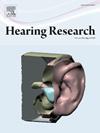通过一种新型复发性气道阻塞装置引起的大鼠间歇性缺氧引起的外周和中枢性听觉功能障碍
IF 2.5
2区 医学
Q1 AUDIOLOGY & SPEECH-LANGUAGE PATHOLOGY
引用次数: 0
摘要
目的研究间歇性缺氧(IH)对听觉阈值、听觉脑干反应(ABR)潜伏期和听觉皮层神经元活动的影响。方法雄性Sprague-Dawley大鼠24只(300 ~ 350 g),随机分为实验组和对照组。使用定制的3d打印口罩,带有单向阀和通风系统,通过定期停止气流诱导实验组IH。对照组佩戴相同的设备,但没有缺氧暴露。使用脉搏血氧仪连续监测血氧饱和度。建立了三维气体动力学模型,验证了面罩内氧气和二氧化碳的动力学。暴露3 h后,记录听觉皮层神经元的ABR和自发放电率(SFR)。结果实验组呈周期性去饱和,最小氧饱和度为80.19±0.34%,最大氧饱和度为97.68±0.31%。24和32 kHz的ABR阈值显著增加,分别为19.17±1.54 dB和25.00±1.83 dB (P <;0.05)。32 kHz时ABR III-V波潜伏期由2.79±0.17 ms显著缩短至2.27±0.16 ms (P <;0.05)。此外,实验组听觉皮质神经元的SFR为2.67±0.18 Hz,对照组为1.02±0.11 Hz (P <;0.01)。结论短期IH诱导高频听力损失,减少ABR潜伏期,增强皮层神经元兴奋性,涉及外周和中枢听觉通路。本文章由计算机程序翻译,如有差异,请以英文原文为准。
Peripheral and central auditory dysfunction induced by intermittent hypoxia via a novel recurrent airway obstruction device in rats
Objective
This study aimed to investigate the effects of intermittent hypoxia (IH) on auditory thresholds, auditory brainstem response (ABR) latency, and neuronal activity in the auditory cortex using a novel recurrent airway obstruction device.
Methods
Twenty-four male Sprague–Dawley rats (300–350 g) were randomly assigned to experimental or control groups. A custom 3D-printed mask with one-way valves and a ventilation system was used to induce IH in the experimental group via periodic airflow cessation. The control group wore the same apparatus without hypoxic exposure. Blood oxygen saturation was continuously monitored using a pulse oximeter. A three-dimensional gas dynamics model was constructed to validate the oxygen and carbon dioxide dynamics within the mask. After 3 h of exposure, ABR and the spontaneous firing rate (SFR) of auditory cortical neurons were recorded.
Results
The experimental group showed periodic desaturation, with minimum and maximum oxygen saturation values of 80.19 ± 0.34 % and 97.68 ± 0.31 %, respectively. ABR thresholds at 24 and 32 kHz significantly increased to 19.17 ± 1.54 dB and 25.00 ± 1.83 dB (P < 0.05). ABR wave III–V latency at 32 kHz was significantly shortened from 2.79 ± 0.17 ms to 2.27 ± 0.16 ms (P < 0.05). Additionally, the SFR of auditory cortical neurons increased to 2.67 ± 0.18 Hz in the experimental group versus 1.02 ± 0.11 Hz in controls (P < 0.01).
Conclusion
Short-term IH induces high-frequency hearing loss, reduces ABR latency, and enhances cortical neuronal excitability, implicating both peripheral and central auditory pathways.
求助全文
通过发布文献求助,成功后即可免费获取论文全文。
去求助
来源期刊

Hearing Research
医学-耳鼻喉科学
CiteScore
5.30
自引率
14.30%
发文量
163
审稿时长
75 days
期刊介绍:
The aim of the journal is to provide a forum for papers concerned with basic peripheral and central auditory mechanisms. Emphasis is on experimental and clinical studies, but theoretical and methodological papers will also be considered. The journal publishes original research papers, review and mini- review articles, rapid communications, method/protocol and perspective articles.
Papers submitted should deal with auditory anatomy, physiology, psychophysics, imaging, modeling and behavioural studies in animals and humans, as well as hearing aids and cochlear implants. Papers dealing with the vestibular system are also considered for publication. Papers on comparative aspects of hearing and on effects of drugs and environmental contaminants on hearing function will also be considered. Clinical papers will be accepted when they contribute to the understanding of normal and pathological hearing functions.
 求助内容:
求助内容: 应助结果提醒方式:
应助结果提醒方式:


